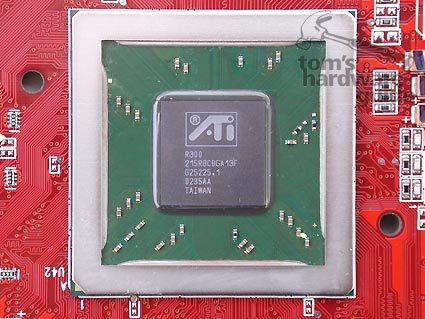Pixel-Churners: A round-up of Radeon 9700 PRO cards
Solid Front
The heart of a Radeon 9700 PRO card, the R300 chip.
Christmas is coming and the latest games are bringing computers to their knees. Fall is the perfect time to get your computer in shape again to cope with the increasingly demanding requirements of games. And if you're looking for the latest and greatest graphics card around, you won't have to look any farther than ATi's new Radeon 9700 PRO. It already supports DirectX 9, even though Microsoft hasn't officially published the latest update for its 3D interface. But even given today's batch of games, it offers far and away the best performance and the highest-quality display capabilities. There is an alternative to 9700 PRO - the NVIDIA GeForce4 Ti4600, which has already started showing its age. While it makes a good showing in the standard benchmarks, it falls off steeply in full-scene antialiasing and anisotropic filtering, lagging considerably behind the new ATi flagship model. The main reason for ATi's lead is the card's 256-bit memory interface, which effectively doubles its memory bandwidth. And that's not counting the four vertex-shader units, compared to the GeForce4 Ti's two, giving a real boost to its polygon capabilities.
The only area where the NVIDIA chip manages to keep up is in pixel pipelines. While it only has four pixel pipelines, as opposed to the eight on the 9700 PRO, each pipeline can calculate two textures per clock and pipe. The fill rates of both cards are roughly equal for games that use multitexturing, basically translating into all current games. Matrox is another competitor, at least in a price comparison. With its vertex shader, the Matrox Parhelia offers hardware-accelerated DirectX 9 features. That said, the pixel shaders are still designed to conform to the DirectX 8.1 standard. Despite its innovative fragment antialiasing and a 256-bit memory interface, it doesn't perform nearly as well as a GeForce4, let alone a Radeon 9700 PRO. The Parhelia's strengths lie more in the 2D arena, such as in multi-monitor environments. It allows up to three monitors to be connected; if you want, you can spread games out to up to three monitors using the Surround Gaming feature. But the chip seems to hit a brick wall at that point: it's nigh on impossible to play new games like Unreal Tournament 2003 in this mode because of the chip's poor 3D capabilities.
Get Tom's Hardware's best news and in-depth reviews, straight to your inbox.
